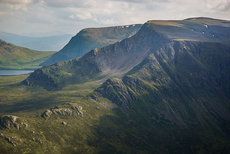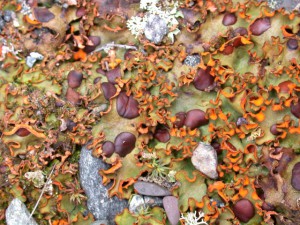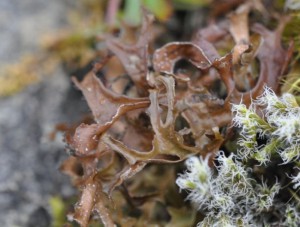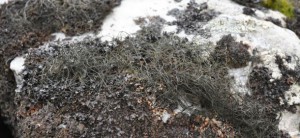
Summer in Scotland at last!
And a holiday for me…although I just can’t switch off my lichen-spotting fascination, especially not when my holiday destination involves going through some of Scotland’s most remote highlands and includes a visit to a lichen hotspot – the Ben Alder mountain range!
 Gloriously sunny weather prevailed, but this is Scotland let’s not forget, and searing sunshine can disappear in almost the blink of an eye, and what follows – especially when in mountainous terrain above 914 metres (or 3,000 feet if you are a keen Munro-er), can be plummeting temperatures and chilling moist winds and/or freezing fog reducing visibility to almost zero. A stark reminder of the extremes of environmental conditions that Scottish montane lichen species are required to be able to adapt to and thrive in.
Gloriously sunny weather prevailed, but this is Scotland let’s not forget, and searing sunshine can disappear in almost the blink of an eye, and what follows – especially when in mountainous terrain above 914 metres (or 3,000 feet if you are a keen Munro-er), can be plummeting temperatures and chilling moist winds and/or freezing fog reducing visibility to almost zero. A stark reminder of the extremes of environmental conditions that Scottish montane lichen species are required to be able to adapt to and thrive in.
These special high montaine areas which are above the upper limit of heather, are home to a vegetation dominated by lichen, moss and sedge heath. A rich community of montane lichen flora (comprising of about 400 species including nearly a third (52) of the British Red List lichens) survive in this environment. On Ben Alder, due to the calcium rich rocks which top the plateaux – a special community of lichens known as ‘arctic-alpines’ thrive. These species must be adapted to extremes of temperature, moisture levels and strong winds.
My eye for lichen spotting has grown keener thoughout my traineeship – without thinking I sieve out the commoner (although by no means less beautiful, intriguing or important) lichens in this habitat, to find those that are nationally if not neccessarily locally rare. Among others I found the stunning Solorina crocea – which is associated with areas of late snow lie or with permanent snow patches, and the less showy ‘shadow’ lichen Cetraria islandica. Lineages of many of the arctic-alpine species found here may have persisted in these areas undisturbed since the end of the Ice Age!
On these remote mountain plateaux and famous ridges such as ‘The Ring of Steall’, I was surprised to see Bryoria species growing in tuffs on rock – Previously I’d only see these ‘hair lichens’ growing luciously long locks on trees in very clean air sites.
During 8 days of walking and wild camping I had to make a concerted effort NOT to begin looking too closely at the ground, eager to spot some of the very interesting but even less obvious heather and soil dwelling lichen species that I had been introduced to on Unst, Shetland… But that didn’t stop me knowing they were there!
It was thrilled by the range of new (to me) lichens I saw and excitedly looked up these to identify them immediately upon my return to the Botanic Garden in Edinburgh.
I begin to wonder what on earth I saw before I saw lichen everywhere?? Just light and shade, subtle mosaics of colour.. or just rock, trees and grass!
I return with a sense of wonder. I marvel at how with each new bit of nature that is revealed to us, that we are introduced to and which we experience, we, if this is done in an inspiring way, can have our eyes opened to extraordinary new worlds within this world, laid out before us to explore further and connect with. With this comes a potential opening for greater understanding and empathy of the incredible wealth of life with which we share this planet, and with this, a desire to protect it.
“No one will protect what they don’t care about; and no one will care about what they have never experienced” Sir David Attenborough
Further sources: Naturally Scottish – Lichens by Oliver Gilbert, published by SNH



